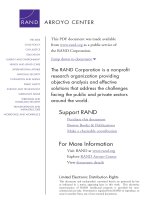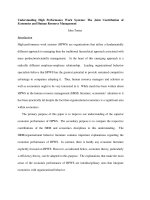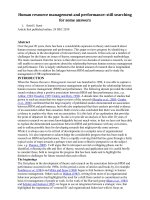Dessler ch 3 strategic human resource management and the HR
Bạn đang xem bản rút gọn của tài liệu. Xem và tải ngay bản đầy đủ của tài liệu tại đây (485.2 KB, 39 trang )
tenth edition
Chapter 3
Strategic Human Resource
Management and the HR Scorecard
© 2005 Prentice Hall Inc.
All rights reserved.
Warm Up….
What has been your experience in a strategic management model within your
organization?
How can HR be instrumental in helping a company create a competitive
advantage?
Are organizations always ready for our help and input?
What makes an organization’s senior leadership ready to listen to HR?
Are strategic plans just the “flavor of the month?”
© 2005 Prentice Hall Inc.
All rights reserved.
3–2
After studying this chapter,
you should be able to:
1.
Outline the steps in the strategic management
process.
2.
Explain and give examples of each type of
companywide and competitive strategy.
3.
Explain what a high performance work system is
and why it is important.
4.
Illustrate and explain each of the seven steps in
the HR Scorecard approach to creating HR
systems.
© 2005 Prentice Hall Inc. All rights reserved.
3–3
3–3
HR’s Strategic Challenges
Strategic plan
– A company’s plan for how it will match its internal strengths and
weaknesses with external opportunities and threats in order to maintain a
competitive advantage.
– Where are we now as a business and where do we want to be?
Three basic challenges HR Managers must address in formulating strategies:
– The need to support corporate productivity and performance improvement
efforts.
– That employees play an expanded role in employers’ performance
improvement efforts. HR must assist with developing organizations.
– HR must be more involved in designing—not just executing—the
company’s strategic plan.
© 2005 Prentice Hall Inc.
All rights reserved.
3–4
The Strategic Management Process
Strategic management
– The process of identifying and executing the organization’s mission by
matching its capabilities with the demands of its environment.
Strategy
– A strategy is a course of action.
– The company’s long-tem plan for how it will balance its internal
strengths and weaknesses with its external opportunities and threats to
maintain a competitive advantage.
© 2005 Prentice Hall Inc.
All rights reserved.
3–5
Several Steps To The Strategic Management Process
– Step 1: Define the Business and Its Mission
– Step 2: Perform External and Internal Audits
– Step 3: Translate the Mission into Strategic Goals
– Step 4: Formulate a Strategy to Achieve the
Strategic Goals
– Step 5: Implement the Strategy
– Step 6: Evaluate Performance
Let’s take a look at each of them…
© 2005 Prentice Hall Inc.
All rights reserved.
3–6
Steps in Strategic Management…
Step 1: Define the Business and Its Mission
Where are we now in terms of business?
What business do we want to be in or expand, even lessen?
We choose our strategies to take us there.
Must have a Vision:
A statement of where the company intends to go, evokes emotional
feelings in organization members.
A mental image of a future desirable state.
What the business should be.
Must have a Mission:
Spells out who the company is, what it does, and where it’s headed.
Tells us who the company is supposed to be now.
Q: What does your company’s vision or mission say about them?
© 2005 Prentice Hall Inc.
All rights reserved.
3–7
Steps in Strategic Management…
Step 2: Perform External and Internal
Audits
SWOT Analysis
The use of a SWOT chart to compile and
organize the process of identifying
company
Strengths,
Weaknesses,
Opportunities, and Threats.
© 2005 Prentice Hall Inc.
All rights reserved.
3–8
Steps in Strategic Management…
Step 3: Translate the Mission Into Strategic Goals
Managers need long-term strategic goals.
What does the mission mean for the next 5 years?
What kinds of partnerships do we form? Short-term goals as well!
Step 4: Formulate a Strategy to Achieve the Strategic Goals
How are we going to get there?
Get the employees involved!!
People will not implement strategies they don’t buy into.
Q: What are your experiences in your organizations?
© 2005 Prentice Hall Inc.
All rights reserved.
3–9
Steps in Strategic Management…
Step 5: Implement The Strategy
Translate the strategy into action and results!
Involves all of the management functionsPlanning
Organizing
Staffing
Leading
Controlling
Step 6: Evaluate Performance
Strategic Control! – Keeps our strategies up to date.
Take constant corrective action as needed.
“Are all the resources we have contributing as planned to achieve our goals?”
“Do we need to revise our plans?”
© 2005 Prentice Hall Inc.
All rights reserved.
3–
10
Overview of Strategic Management
© 2005 Prentice Hall Inc.
All rights reserved.
3–
11
Figure 3–1
Strategies in Brief
Company
Strategic Principle
Dell
Be direct
eBay
Focus on trading communities
General Electric
Be number one or number two in every
industry in which we compete, or get out
Southwest Airlines
Meet customers’ short-haul travel needs
at fares competitive with the cost of
automobile travel
Vanguard
Unmatchable value for the investor-owner
Wal-Mart
Low prices, every day
© 2005 Prentice Hall Inc.
All rights reserved.
Source: Arit Gadiesh and James Gilbert, “Frontline Action,” Harvard Business Review, May 2001, p. 74.
3–
12
Figure 3–3
What Exactly Are The Kinds of Strategies Used By
Companies?
Corporate-Level Strategies
Business-Level Strategies
Functional Strategies
© 2005 Prentice Hall Inc.
All rights reserved.
3–
13
Types of Strategic Planning
Corporate-level strategy
– Identifies the portfolio of businesses that, in total, comprise the
company and the ways in which these businesses relate to each
other.
– For example, PepsiCo owns Frito-Lay, Pepsi, Pizza Hut.
– 4 strategies used here:
• Diversification strategy implies that the firm will expand by
adding new product lines.
• Vertical integration strategy means the firm expands by
producing its own raw materials, or selling its products direct.
• Consolidation strategy reduces the company’s size.
• Geographic expansion strategy takes the company abroad.
© 2005 Prentice Hall Inc.
All rights reserved.
3–
14
Types of Strategic Planning (cont’d)
Business-level/competitive strategy
– Identifies how to build and strengthen the business’s long-term
competitive position in the marketplace.
– Breaks down each of the businesses (Frito-Lay, Pizza Hut, etc.)
– At this stage we focus on strategies to affect a competitive advantage:
• Cost leadership: the enterprise aims to become the low-cost leader
in an industry.
• Differentiation: a firm seeks to be unique in its industry along
dimensions that are widely valued by buyers.
• Focus: a firm seeks to carve out a market niche, and compete by
providing a product or service customers can get in no other way.
© 2005 Prentice Hall Inc.
All rights reserved.
3–
15
What is Competitive Advantage?
Competitive advantage
– Any factors that allow an organization to differentiate its
product or service from those of its competitors to increase
market share.
– Superior human resources are an important source of
competitive advantage
– Other forms: Software, research team, management
systems
© 2005 Prentice Hall Inc.
All rights reserved.
3–
16
Types of Strategic Planning (cont’d)
Functional strategies
– Identify the basic courses of action that each department will pursue
in order to help the business attain its competitive goals.
– Departments such as manufacturing, sales, HR, etc.
– Each department must make a plan, provide to management.
– Must get employees involved!
© 2005 Prentice Hall Inc.
All rights reserved.
3–
17
Summary Among Strategies
in Multiple- Business Firms
© 2005 Prentice Hall Inc.
All rights reserved.
3–
18
Figure 3–4
How Do Companies Achieve Strategic Fit?
The question with managers is….”should managers “fit” capabilities to the
opportunities and threats or “stretch” beyond their capabilities to take
advantage of an opportunity?”
Michael Porter
– Emphasizes the “fit” point of view that all of the firm’s activities
must be tailored to or fit its strategy, by ensuring that the firm’s
functional strategies support its corporate and competitive
strategies.
– “It’s this “fit” that breathes life into the firm’s strategy.”
Gary Hamel and C. K. Prahalad
– Argue for “stretch” in leveraging resources—supplementing what
you have and doing more with what you have—can be more
important than just fitting the strategic plan to current resources.
© 2005 Prentice Hall Inc.
All rights reserved.
3–
19
The Southwest
Airlines’ Activity
System
© 2005 Prentice Hall Inc.
All rights reserved.
Source: Reprinted by permission of Harvard Business Review. From “What is Strategy?” by Michael E. Porter,
November–December 1996. Copyright © 1996 by the President and Fellows of Harvard College, all rights reserved.
3–
20
Figure 3–5
So What Is Strategic Human Resource Management?
The linking of HRM with strategic goals and objectives in order
to improve business performance and develop organizational
cultures that foster innovation and flexibility.
Formulating and executing HR systems—HR policies and
activities—that produce the employee competencies and
behaviors the company needs to achieve its strategic aims.
Examples:
Building Better Communication
Coaching Managers
Developing Better Recruitment Systems
© 2005 Prentice Hall Inc.
All rights reserved.
3–
21
Linking Corporate and HR Strategies
© 2005 Prentice Hall Inc.
All rights reserved.
Source: © 2003, Gary Dessler, Ph.D.
3–
22
Figure 3–6
HR’S Strategic Roles
HR professionals should be part of the firm’s strategic planning
executive team.
– Identify the human issues that are vital to business strategy.
– Help establish and execute strategy.
– Provide alternative insights.
– Are centrally involved in creating responsive and market-driven
organizations.
– Conceptualize and execute organizational change.
39% of CEOs view HR as more of a partner than a cost center.
Mergers in which HR has been more prevalent have been more successful.
© 2005
Prentice Hall Inc.
3–
All rights reserved.
23
HR Involvement in Mergers
© 2005 Prentice Hall Inc.
All rights reserved.
Source: Jeffrey Schmidt, “The Correct Spelling of M & A Begins with HR,” HR Magazine, June 2001, p. 105.
3–
24
Figure 3–7
To Be Strategic, HR Must Understand Value of a Firm
Break into your groups and discuss the following:
How does your company make money?
What creates wealth for your company as defined by your customers and
also just as importantly, your employees?
Who in your organization manages/monitors these activities each day?
What is the feedback given to the field?
What is your HR’s involvement in this process?
Be ready to share in class.
© 2005 Prentice Hall Inc.
All rights reserved.
3–
25









